Exploring Social Determinants of Health Through a Case Study
VerifiedAdded on 2022/07/29
|7
|1905
|62
Report
AI Summary
This report analyzes the social determinants of health evident in the case study of Carl, examining the influence of socio-demographic characteristics such as education, employment, and family dynamics. It identifies key social determinants, including the physical environment, income levels, access to education, and health services, and their combined impact on Carl and her family's well-being. The report highlights education as a critical factor in addressing these determinants and proposes interventions such as improving access to schools and resources. Furthermore, it emphasizes the role of healthcare professionals in raising awareness, advocating for policy changes, and empowering communities to improve health outcomes by addressing social inequalities. The conclusion underscores the complex interplay of these determinants and their impact on individuals' lives.
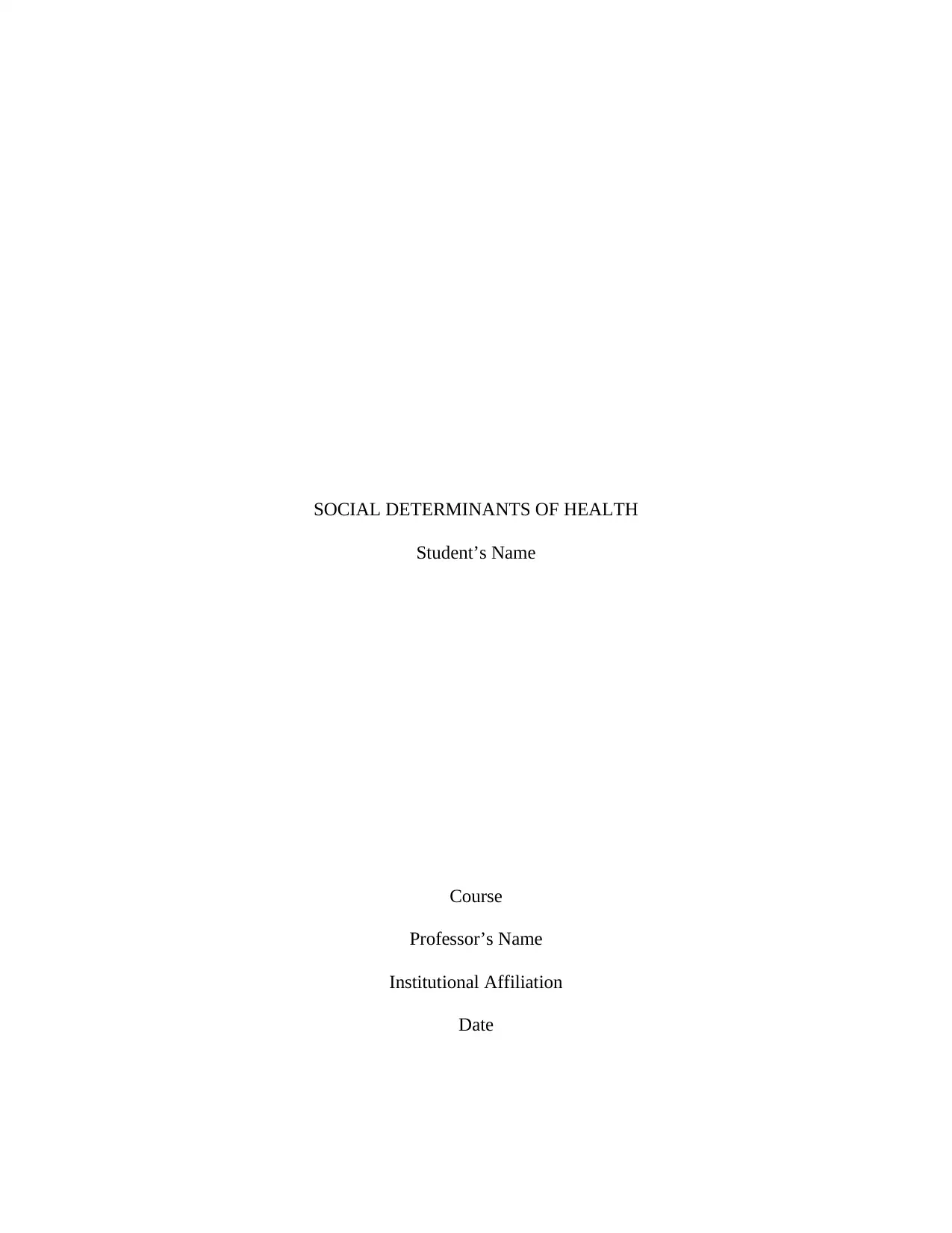
SOCIAL DETERMINANTS OF HEALTH
Student’s Name
Course
Professor’s Name
Institutional Affiliation
Date
Student’s Name
Course
Professor’s Name
Institutional Affiliation
Date
Paraphrase This Document
Need a fresh take? Get an instant paraphrase of this document with our AI Paraphraser
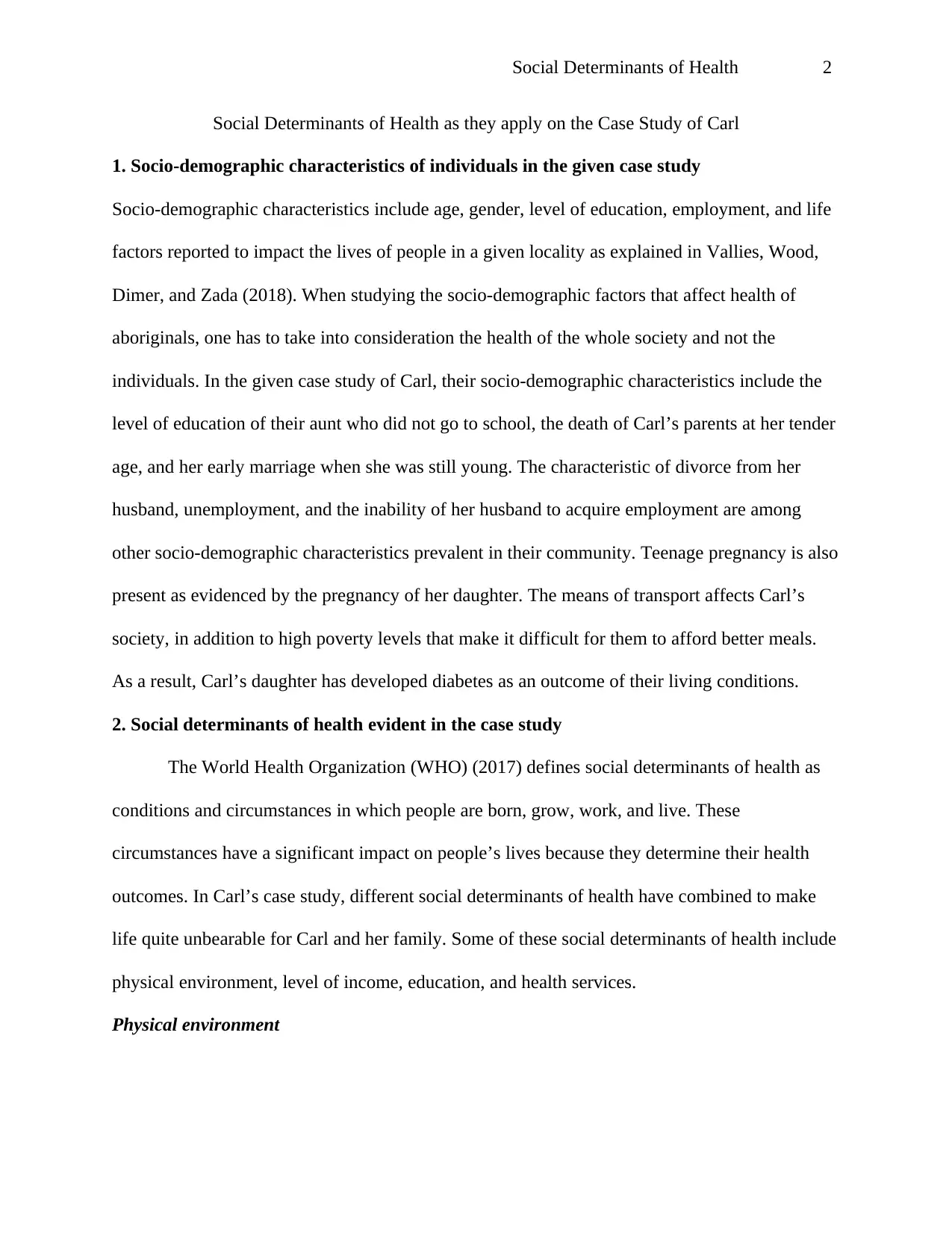
Social Determinants of Health 2
Social Determinants of Health as they apply on the Case Study of Carl
1. Socio-demographic characteristics of individuals in the given case study
Socio-demographic characteristics include age, gender, level of education, employment, and life
factors reported to impact the lives of people in a given locality as explained in Vallies, Wood,
Dimer, and Zada (2018). When studying the socio-demographic factors that affect health of
aboriginals, one has to take into consideration the health of the whole society and not the
individuals. In the given case study of Carl, their socio-demographic characteristics include the
level of education of their aunt who did not go to school, the death of Carl’s parents at her tender
age, and her early marriage when she was still young. The characteristic of divorce from her
husband, unemployment, and the inability of her husband to acquire employment are among
other socio-demographic characteristics prevalent in their community. Teenage pregnancy is also
present as evidenced by the pregnancy of her daughter. The means of transport affects Carl’s
society, in addition to high poverty levels that make it difficult for them to afford better meals.
As a result, Carl’s daughter has developed diabetes as an outcome of their living conditions.
2. Social determinants of health evident in the case study
The World Health Organization (WHO) (2017) defines social determinants of health as
conditions and circumstances in which people are born, grow, work, and live. These
circumstances have a significant impact on people’s lives because they determine their health
outcomes. In Carl’s case study, different social determinants of health have combined to make
life quite unbearable for Carl and her family. Some of these social determinants of health include
physical environment, level of income, education, and health services.
Physical environment
Social Determinants of Health as they apply on the Case Study of Carl
1. Socio-demographic characteristics of individuals in the given case study
Socio-demographic characteristics include age, gender, level of education, employment, and life
factors reported to impact the lives of people in a given locality as explained in Vallies, Wood,
Dimer, and Zada (2018). When studying the socio-demographic factors that affect health of
aboriginals, one has to take into consideration the health of the whole society and not the
individuals. In the given case study of Carl, their socio-demographic characteristics include the
level of education of their aunt who did not go to school, the death of Carl’s parents at her tender
age, and her early marriage when she was still young. The characteristic of divorce from her
husband, unemployment, and the inability of her husband to acquire employment are among
other socio-demographic characteristics prevalent in their community. Teenage pregnancy is also
present as evidenced by the pregnancy of her daughter. The means of transport affects Carl’s
society, in addition to high poverty levels that make it difficult for them to afford better meals.
As a result, Carl’s daughter has developed diabetes as an outcome of their living conditions.
2. Social determinants of health evident in the case study
The World Health Organization (WHO) (2017) defines social determinants of health as
conditions and circumstances in which people are born, grow, work, and live. These
circumstances have a significant impact on people’s lives because they determine their health
outcomes. In Carl’s case study, different social determinants of health have combined to make
life quite unbearable for Carl and her family. Some of these social determinants of health include
physical environment, level of income, education, and health services.
Physical environment
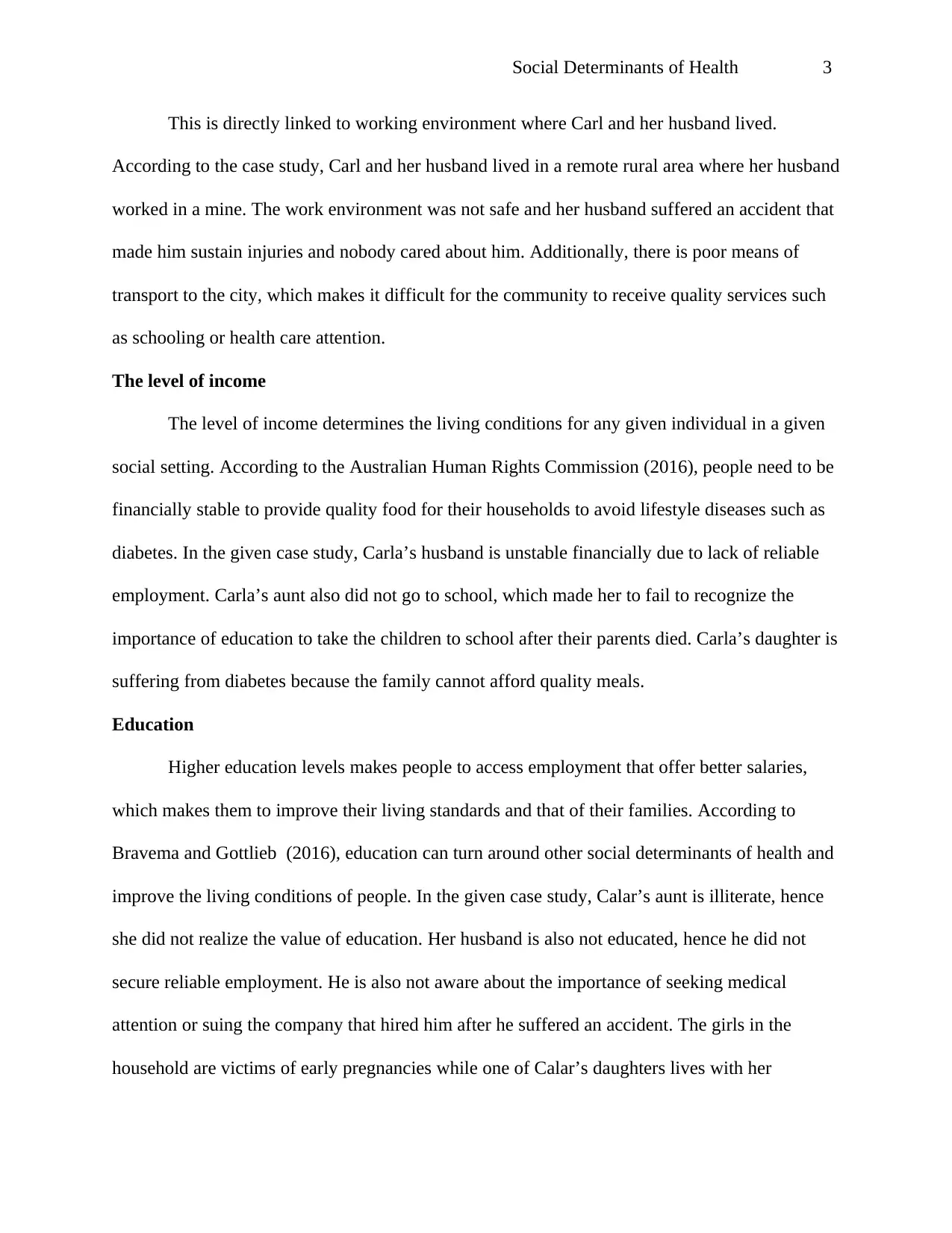
Social Determinants of Health 3
This is directly linked to working environment where Carl and her husband lived.
According to the case study, Carl and her husband lived in a remote rural area where her husband
worked in a mine. The work environment was not safe and her husband suffered an accident that
made him sustain injuries and nobody cared about him. Additionally, there is poor means of
transport to the city, which makes it difficult for the community to receive quality services such
as schooling or health care attention.
The level of income
The level of income determines the living conditions for any given individual in a given
social setting. According to the Australian Human Rights Commission (2016), people need to be
financially stable to provide quality food for their households to avoid lifestyle diseases such as
diabetes. In the given case study, Carla’s husband is unstable financially due to lack of reliable
employment. Carla’s aunt also did not go to school, which made her to fail to recognize the
importance of education to take the children to school after their parents died. Carla’s daughter is
suffering from diabetes because the family cannot afford quality meals.
Education
Higher education levels makes people to access employment that offer better salaries,
which makes them to improve their living standards and that of their families. According to
Bravema and Gottlieb (2016), education can turn around other social determinants of health and
improve the living conditions of people. In the given case study, Calar’s aunt is illiterate, hence
she did not realize the value of education. Her husband is also not educated, hence he did not
secure reliable employment. He is also not aware about the importance of seeking medical
attention or suing the company that hired him after he suffered an accident. The girls in the
household are victims of early pregnancies while one of Calar’s daughters lives with her
This is directly linked to working environment where Carl and her husband lived.
According to the case study, Carl and her husband lived in a remote rural area where her husband
worked in a mine. The work environment was not safe and her husband suffered an accident that
made him sustain injuries and nobody cared about him. Additionally, there is poor means of
transport to the city, which makes it difficult for the community to receive quality services such
as schooling or health care attention.
The level of income
The level of income determines the living conditions for any given individual in a given
social setting. According to the Australian Human Rights Commission (2016), people need to be
financially stable to provide quality food for their households to avoid lifestyle diseases such as
diabetes. In the given case study, Carla’s husband is unstable financially due to lack of reliable
employment. Carla’s aunt also did not go to school, which made her to fail to recognize the
importance of education to take the children to school after their parents died. Carla’s daughter is
suffering from diabetes because the family cannot afford quality meals.
Education
Higher education levels makes people to access employment that offer better salaries,
which makes them to improve their living standards and that of their families. According to
Bravema and Gottlieb (2016), education can turn around other social determinants of health and
improve the living conditions of people. In the given case study, Calar’s aunt is illiterate, hence
she did not realize the value of education. Her husband is also not educated, hence he did not
secure reliable employment. He is also not aware about the importance of seeking medical
attention or suing the company that hired him after he suffered an accident. The girls in the
household are victims of early pregnancies while one of Calar’s daughters lives with her
⊘ This is a preview!⊘
Do you want full access?
Subscribe today to unlock all pages.

Trusted by 1+ million students worldwide
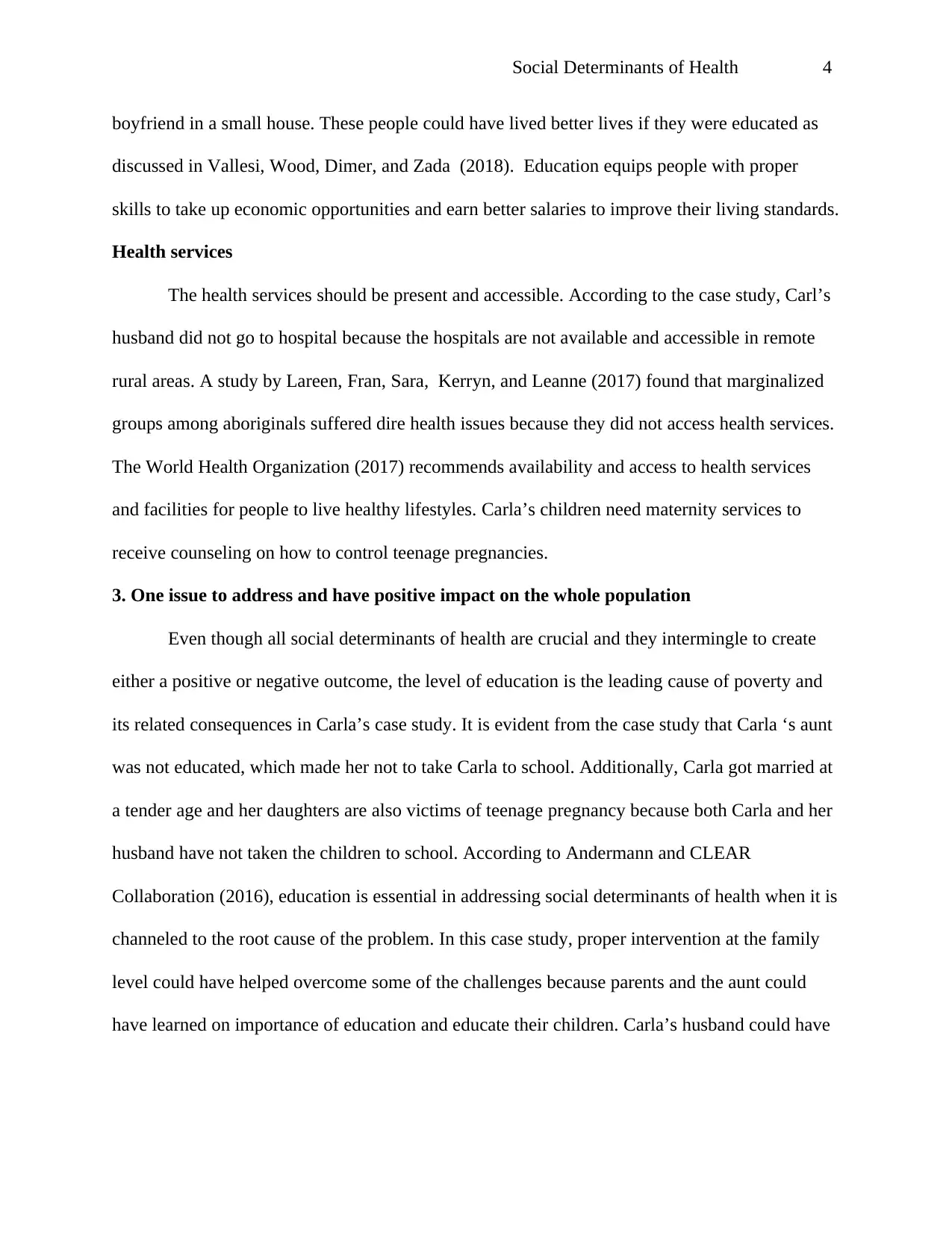
Social Determinants of Health 4
boyfriend in a small house. These people could have lived better lives if they were educated as
discussed in Vallesi, Wood, Dimer, and Zada (2018). Education equips people with proper
skills to take up economic opportunities and earn better salaries to improve their living standards.
Health services
The health services should be present and accessible. According to the case study, Carl’s
husband did not go to hospital because the hospitals are not available and accessible in remote
rural areas. A study by Lareen, Fran, Sara, Kerryn, and Leanne (2017) found that marginalized
groups among aboriginals suffered dire health issues because they did not access health services.
The World Health Organization (2017) recommends availability and access to health services
and facilities for people to live healthy lifestyles. Carla’s children need maternity services to
receive counseling on how to control teenage pregnancies.
3. One issue to address and have positive impact on the whole population
Even though all social determinants of health are crucial and they intermingle to create
either a positive or negative outcome, the level of education is the leading cause of poverty and
its related consequences in Carla’s case study. It is evident from the case study that Carla ‘s aunt
was not educated, which made her not to take Carla to school. Additionally, Carla got married at
a tender age and her daughters are also victims of teenage pregnancy because both Carla and her
husband have not taken the children to school. According to Andermann and CLEAR
Collaboration (2016), education is essential in addressing social determinants of health when it is
channeled to the root cause of the problem. In this case study, proper intervention at the family
level could have helped overcome some of the challenges because parents and the aunt could
have learned on importance of education and educate their children. Carla’s husband could have
boyfriend in a small house. These people could have lived better lives if they were educated as
discussed in Vallesi, Wood, Dimer, and Zada (2018). Education equips people with proper
skills to take up economic opportunities and earn better salaries to improve their living standards.
Health services
The health services should be present and accessible. According to the case study, Carl’s
husband did not go to hospital because the hospitals are not available and accessible in remote
rural areas. A study by Lareen, Fran, Sara, Kerryn, and Leanne (2017) found that marginalized
groups among aboriginals suffered dire health issues because they did not access health services.
The World Health Organization (2017) recommends availability and access to health services
and facilities for people to live healthy lifestyles. Carla’s children need maternity services to
receive counseling on how to control teenage pregnancies.
3. One issue to address and have positive impact on the whole population
Even though all social determinants of health are crucial and they intermingle to create
either a positive or negative outcome, the level of education is the leading cause of poverty and
its related consequences in Carla’s case study. It is evident from the case study that Carla ‘s aunt
was not educated, which made her not to take Carla to school. Additionally, Carla got married at
a tender age and her daughters are also victims of teenage pregnancy because both Carla and her
husband have not taken the children to school. According to Andermann and CLEAR
Collaboration (2016), education is essential in addressing social determinants of health when it is
channeled to the root cause of the problem. In this case study, proper intervention at the family
level could have helped overcome some of the challenges because parents and the aunt could
have learned on importance of education and educate their children. Carla’s husband could have
Paraphrase This Document
Need a fresh take? Get an instant paraphrase of this document with our AI Paraphraser
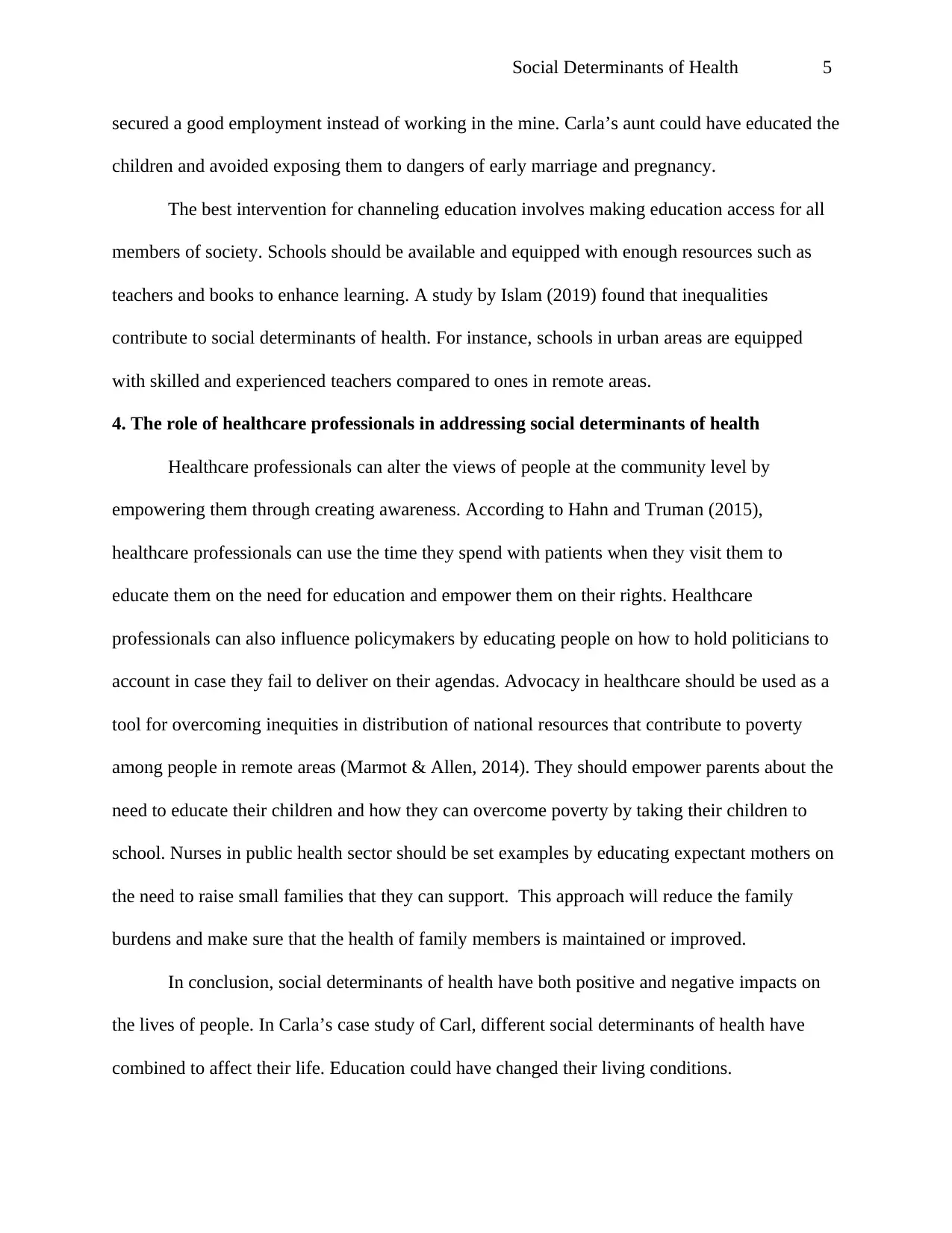
Social Determinants of Health 5
secured a good employment instead of working in the mine. Carla’s aunt could have educated the
children and avoided exposing them to dangers of early marriage and pregnancy.
The best intervention for channeling education involves making education access for all
members of society. Schools should be available and equipped with enough resources such as
teachers and books to enhance learning. A study by Islam (2019) found that inequalities
contribute to social determinants of health. For instance, schools in urban areas are equipped
with skilled and experienced teachers compared to ones in remote areas.
4. The role of healthcare professionals in addressing social determinants of health
Healthcare professionals can alter the views of people at the community level by
empowering them through creating awareness. According to Hahn and Truman (2015),
healthcare professionals can use the time they spend with patients when they visit them to
educate them on the need for education and empower them on their rights. Healthcare
professionals can also influence policymakers by educating people on how to hold politicians to
account in case they fail to deliver on their agendas. Advocacy in healthcare should be used as a
tool for overcoming inequities in distribution of national resources that contribute to poverty
among people in remote areas (Marmot & Allen, 2014). They should empower parents about the
need to educate their children and how they can overcome poverty by taking their children to
school. Nurses in public health sector should be set examples by educating expectant mothers on
the need to raise small families that they can support. This approach will reduce the family
burdens and make sure that the health of family members is maintained or improved.
In conclusion, social determinants of health have both positive and negative impacts on
the lives of people. In Carla’s case study of Carl, different social determinants of health have
combined to affect their life. Education could have changed their living conditions.
secured a good employment instead of working in the mine. Carla’s aunt could have educated the
children and avoided exposing them to dangers of early marriage and pregnancy.
The best intervention for channeling education involves making education access for all
members of society. Schools should be available and equipped with enough resources such as
teachers and books to enhance learning. A study by Islam (2019) found that inequalities
contribute to social determinants of health. For instance, schools in urban areas are equipped
with skilled and experienced teachers compared to ones in remote areas.
4. The role of healthcare professionals in addressing social determinants of health
Healthcare professionals can alter the views of people at the community level by
empowering them through creating awareness. According to Hahn and Truman (2015),
healthcare professionals can use the time they spend with patients when they visit them to
educate them on the need for education and empower them on their rights. Healthcare
professionals can also influence policymakers by educating people on how to hold politicians to
account in case they fail to deliver on their agendas. Advocacy in healthcare should be used as a
tool for overcoming inequities in distribution of national resources that contribute to poverty
among people in remote areas (Marmot & Allen, 2014). They should empower parents about the
need to educate their children and how they can overcome poverty by taking their children to
school. Nurses in public health sector should be set examples by educating expectant mothers on
the need to raise small families that they can support. This approach will reduce the family
burdens and make sure that the health of family members is maintained or improved.
In conclusion, social determinants of health have both positive and negative impacts on
the lives of people. In Carla’s case study of Carl, different social determinants of health have
combined to affect their life. Education could have changed their living conditions.

Social Determinants of Health 6
⊘ This is a preview!⊘
Do you want full access?
Subscribe today to unlock all pages.

Trusted by 1+ million students worldwide
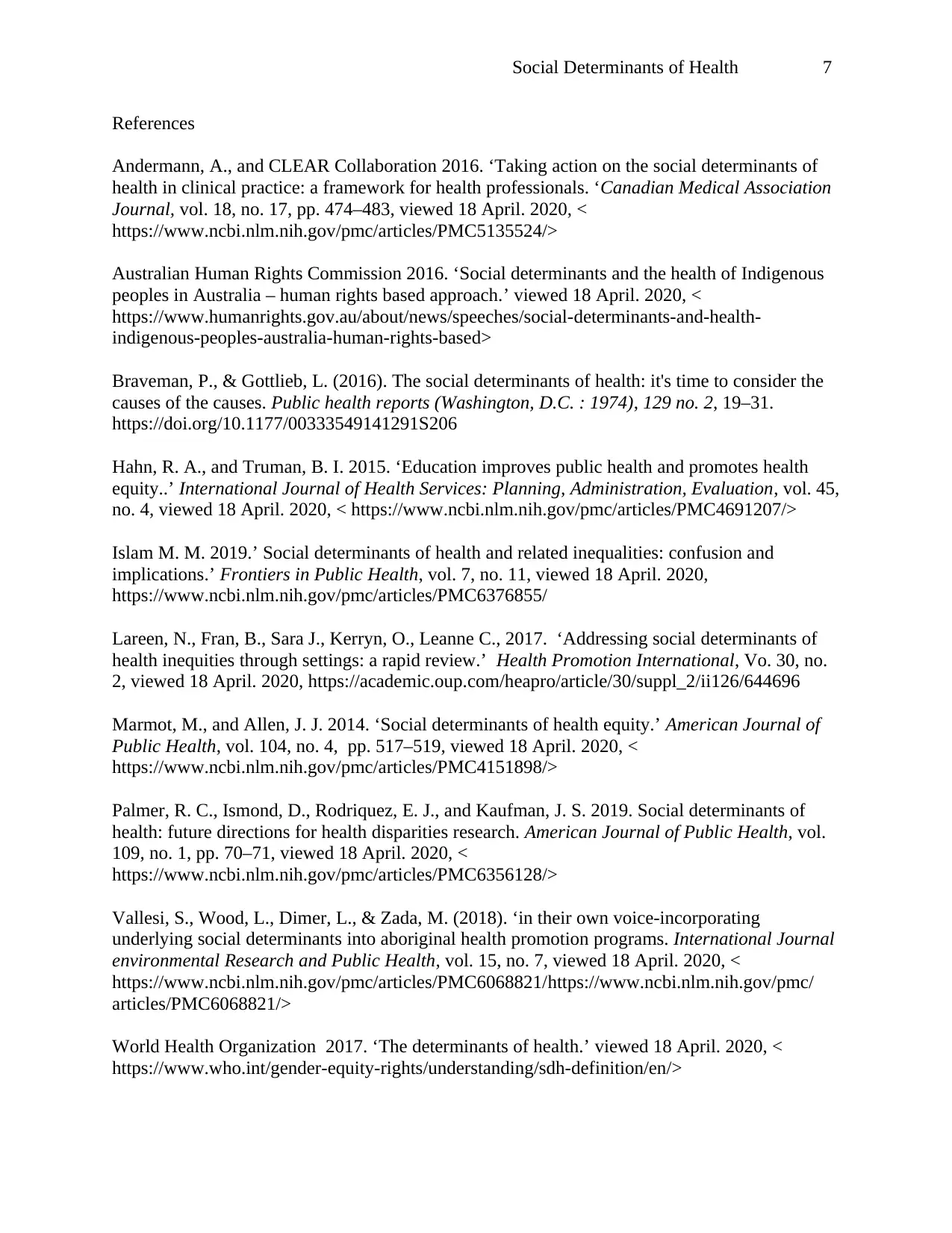
Social Determinants of Health 7
References
Andermann, A., and CLEAR Collaboration 2016. ‘Taking action on the social determinants of
health in clinical practice: a framework for health professionals. ‘Canadian Medical Association
Journal, vol. 18, no. 17, pp. 474–483, viewed 18 April. 2020, <
https://www.ncbi.nlm.nih.gov/pmc/articles/PMC5135524/>
Australian Human Rights Commission 2016. ‘Social determinants and the health of Indigenous
peoples in Australia – human rights based approach.’ viewed 18 April. 2020, <
https://www.humanrights.gov.au/about/news/speeches/social-determinants-and-health-
indigenous-peoples-australia-human-rights-based>
Braveman, P., & Gottlieb, L. (2016). The social determinants of health: it's time to consider the
causes of the causes. Public health reports (Washington, D.C. : 1974), 129 no. 2, 19–31.
https://doi.org/10.1177/00333549141291S206
Hahn, R. A., and Truman, B. I. 2015. ‘Education improves public health and promotes health
equity..’ International Journal of Health Services: Planning, Administration, Evaluation, vol. 45,
no. 4, viewed 18 April. 2020, < https://www.ncbi.nlm.nih.gov/pmc/articles/PMC4691207/>
Islam M. M. 2019.’ Social determinants of health and related inequalities: confusion and
implications.’ Frontiers in Public Health, vol. 7, no. 11, viewed 18 April. 2020,
https://www.ncbi.nlm.nih.gov/pmc/articles/PMC6376855/
Lareen, N., Fran, B., Sara J., Kerryn, O., Leanne C., 2017. ‘Addressing social determinants of
health inequities through settings: a rapid review.’ Health Promotion International, Vo. 30, no.
2, viewed 18 April. 2020, https://academic.oup.com/heapro/article/30/suppl_2/ii126/644696
Marmot, M., and Allen, J. J. 2014. ‘Social determinants of health equity.’ American Journal of
Public Health, vol. 104, no. 4, pp. 517–519, viewed 18 April. 2020, <
https://www.ncbi.nlm.nih.gov/pmc/articles/PMC4151898/>
Palmer, R. C., Ismond, D., Rodriquez, E. J., and Kaufman, J. S. 2019. Social determinants of
health: future directions for health disparities research. American Journal of Public Health, vol.
109, no. 1, pp. 70–71, viewed 18 April. 2020, <
https://www.ncbi.nlm.nih.gov/pmc/articles/PMC6356128/>
Vallesi, S., Wood, L., Dimer, L., & Zada, M. (2018). ‘in their own voice-incorporating
underlying social determinants into aboriginal health promotion programs. International Journal
environmental Research and Public Health, vol. 15, no. 7, viewed 18 April. 2020, <
https://www.ncbi.nlm.nih.gov/pmc/articles/PMC6068821/https://www.ncbi.nlm.nih.gov/pmc/
articles/PMC6068821/>
World Health Organization 2017. ‘The determinants of health.’ viewed 18 April. 2020, <
https://www.who.int/gender-equity-rights/understanding/sdh-definition/en/>
References
Andermann, A., and CLEAR Collaboration 2016. ‘Taking action on the social determinants of
health in clinical practice: a framework for health professionals. ‘Canadian Medical Association
Journal, vol. 18, no. 17, pp. 474–483, viewed 18 April. 2020, <
https://www.ncbi.nlm.nih.gov/pmc/articles/PMC5135524/>
Australian Human Rights Commission 2016. ‘Social determinants and the health of Indigenous
peoples in Australia – human rights based approach.’ viewed 18 April. 2020, <
https://www.humanrights.gov.au/about/news/speeches/social-determinants-and-health-
indigenous-peoples-australia-human-rights-based>
Braveman, P., & Gottlieb, L. (2016). The social determinants of health: it's time to consider the
causes of the causes. Public health reports (Washington, D.C. : 1974), 129 no. 2, 19–31.
https://doi.org/10.1177/00333549141291S206
Hahn, R. A., and Truman, B. I. 2015. ‘Education improves public health and promotes health
equity..’ International Journal of Health Services: Planning, Administration, Evaluation, vol. 45,
no. 4, viewed 18 April. 2020, < https://www.ncbi.nlm.nih.gov/pmc/articles/PMC4691207/>
Islam M. M. 2019.’ Social determinants of health and related inequalities: confusion and
implications.’ Frontiers in Public Health, vol. 7, no. 11, viewed 18 April. 2020,
https://www.ncbi.nlm.nih.gov/pmc/articles/PMC6376855/
Lareen, N., Fran, B., Sara J., Kerryn, O., Leanne C., 2017. ‘Addressing social determinants of
health inequities through settings: a rapid review.’ Health Promotion International, Vo. 30, no.
2, viewed 18 April. 2020, https://academic.oup.com/heapro/article/30/suppl_2/ii126/644696
Marmot, M., and Allen, J. J. 2014. ‘Social determinants of health equity.’ American Journal of
Public Health, vol. 104, no. 4, pp. 517–519, viewed 18 April. 2020, <
https://www.ncbi.nlm.nih.gov/pmc/articles/PMC4151898/>
Palmer, R. C., Ismond, D., Rodriquez, E. J., and Kaufman, J. S. 2019. Social determinants of
health: future directions for health disparities research. American Journal of Public Health, vol.
109, no. 1, pp. 70–71, viewed 18 April. 2020, <
https://www.ncbi.nlm.nih.gov/pmc/articles/PMC6356128/>
Vallesi, S., Wood, L., Dimer, L., & Zada, M. (2018). ‘in their own voice-incorporating
underlying social determinants into aboriginal health promotion programs. International Journal
environmental Research and Public Health, vol. 15, no. 7, viewed 18 April. 2020, <
https://www.ncbi.nlm.nih.gov/pmc/articles/PMC6068821/https://www.ncbi.nlm.nih.gov/pmc/
articles/PMC6068821/>
World Health Organization 2017. ‘The determinants of health.’ viewed 18 April. 2020, <
https://www.who.int/gender-equity-rights/understanding/sdh-definition/en/>
1 out of 7
Related Documents
Your All-in-One AI-Powered Toolkit for Academic Success.
+13062052269
info@desklib.com
Available 24*7 on WhatsApp / Email
![[object Object]](/_next/static/media/star-bottom.7253800d.svg)
Unlock your academic potential
Copyright © 2020–2025 A2Z Services. All Rights Reserved. Developed and managed by ZUCOL.





